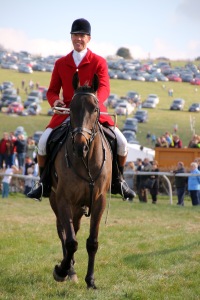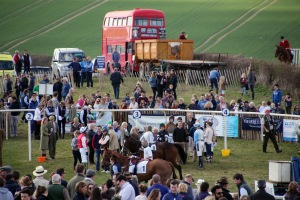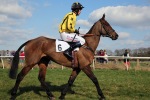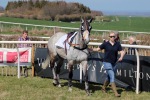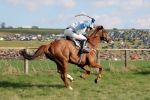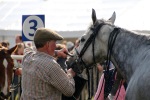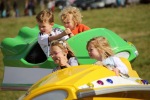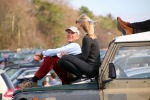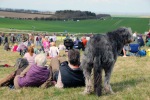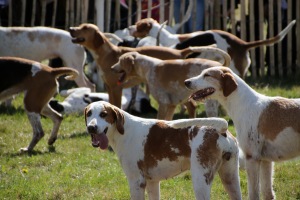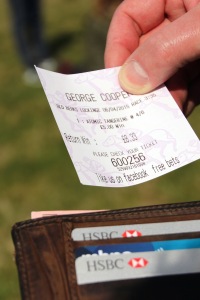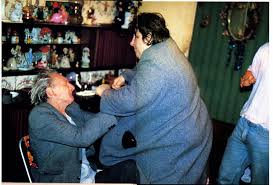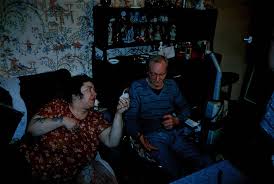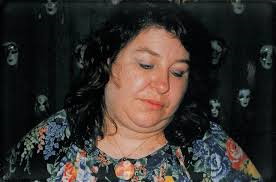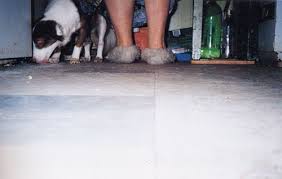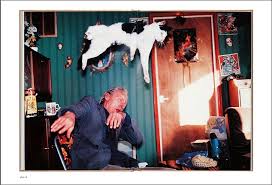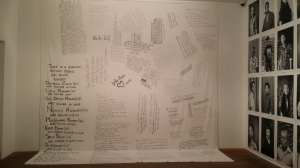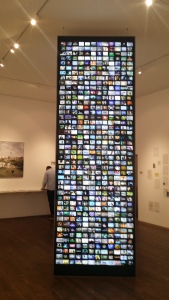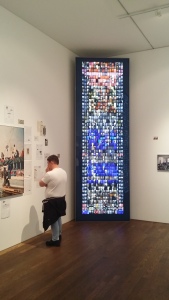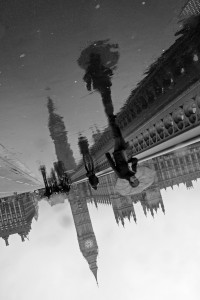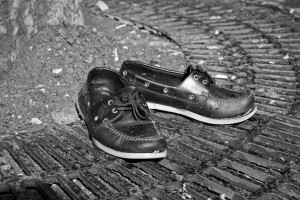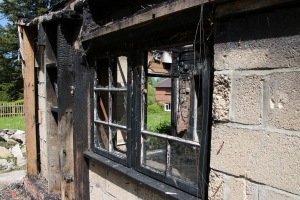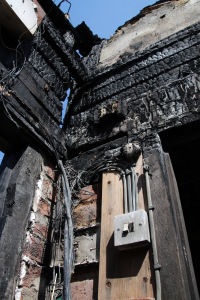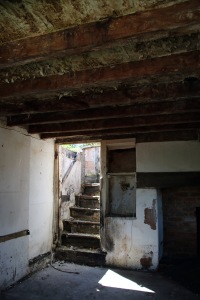I was really interested to attend this visit not only because I live in Oxford and wouldn’t have to make the trek to London, but also the hospital venue was the same environment as an exhibition I was involved in at Oxford several years ago. I was intrigued to find out how the group of Level 3 OCA students collaborated their ideas and work and how the exhibition space was acquired in order that I could compare it to my experience. It is also lovely to view the work of fellow students albeit at a higher level, to gain an insight and understanding of their ideas as well as get an idea of the standard of work required at that level.
The idea of the Memory Exhibition came from student John Umney who volunteers with arts and health charity Artscape at the Nuffield Orthopaedic Centre in Oxford. The Project Manager for Artscape – Tom Cox offered John the free art-space to exhibit photographic images. Opening this opportunity up to OCA Level 3 students, John asked fellow student Penny Watson to collaborate with him on the project resulting in 7 views by 7 photographers totalling 49 images in the exhibition.
The theme of “Memory” was chosen because of its openness to interpretation. In an article in The Oxford Times, Thursday 11th June 2015 , John Said:
“The work we are showing is about that most fallible of human functions – memory. The images are diverse, dealing with the very personal to the corporate. We have interpreted the theme of memory in different ways.”
http://www.oxfordtimes.co.uk/leisure/focus/13327173.For_Art_s_Sake_with_John_Umney/
The photographs in Memory are all of the past but are evidence of a moment in time in a visual form. They are all individual narratives experienced or produced by the individual photographers, but what the viewer see’s is a narrative that reflects their own experiences evoking personal memories.
The work featured in this exhibition was by:
Mike Cookson – Recollective
The weight of memory through casually captured selfies and “we were there” photos, to more reflective images recording tragedies and remembrances to war and bloodshed.
Keith Greenough – Lifting the curtain
Fascinated by East London and how it has been shaped by history, Keith used text from Charles Booth’s 1889 sociocultural survey – Life and Labour of the People. Re-visiting the areas, Keith photographed the sites described as they are today which juxtapose the texts written in 1889 describing what was witnessed in these areas at that time.
Keith was at the study visit and it was delightful to talk with him about how the project started, how he researched the sites using Google Earth and the trials of shooting the images at night to eliminate any modern people. So many times I have visited exhibitions and wished I could talk to the artist in person about their motives and working practice so it was a real treat having Keith there.
John Umney – Are you still there?
Images taken by the emotional response to light accompanied by un-related words or text that were written by the artist or to him from others. Thought provoking – requiring the viewer to make up their own narrative and realising that images like words can mean one thing one day and something totally different the next.
Sue Jones – Remembering I’m ill
Suffering with ME resulting in crippling fatigue and memory problems, Sue has portrayed herself in various guises pre illness and in others where activities render her housebound.
Penny Watson – Eudosia
An exploration of the relationship between children and their landscape. Foraging for foliage and the connection with nature returning childhood memories.
Margaret Taylor – Vandals or memories
A series of trees with carved graffiti questioning whether people leave their marks on trees as vandals or with the desire to be remembered and render themselves immortal?
Mirjam Bollag Dondi – along the frozen valley
Beautiful collection of frozen water and riverscapes with the heart wrenching narrative of mourning and memories that we all have or will experience:
We used to hike along the frozen river… But now you left – to live in the land of not remembering – and so I walk alone
The full exhibition brochure containing further information on each body of work can be accessed below.
Click to access z-final-exhibition-brochure-27-april.pdf
The exhibition I was involved in was part of a group (5 students and 1 tutor) on an advanced adult learning photography course. We thought it would be good experience to hold an exhibition of our work as part of Oxfordshire Art Weeks. The space for our exhibition was also a hospital venue – the John Radcliffe, Oxford and was acquired by a fellow student who had previously expressed an interest in using the space and was awarded it on a lottery basis.
The first difference I noticed was how professional the art space for the Memory exhibition looked. Not only did it extend through different parts of the hospital but offered a professional hanging rail making the final display look really slick. In contrast our exhibition space was one long wall in the main corridor on the ground floor of the hospital. The wall was really tatty – bearing scars of old posters, drawing pins and holes from old picture hooks. To spruce this up we invested in a long roll of white sheeting, which we nailed along the wall to provide a pristine background!!
I can see the advantages and disadvantages of the space in both venues. In ours the 6 bodies of work were displayed together giving viewers the opportunity to see the whole exhibition as they walked along the corridor. Whilst this had visual impact on the viewer seeing the work grouped together, for somebody not stopping to ponder or read whilst walking by, the identities of us as photographers were less obvious as the bodies of work would appear blended as one.
However, with the layout of Memory, I felt there was a danger that people would only see part of the exhibition depending on which part of the hospital they worked or visited, especially as there were no leaflets for people to read, indicating the exhibition continued elsewhere. On the other hand separating the work with different areas or using doors in the walls to act as break points, I felt viewers of Memory would be better able to focus on an individual photographer one at a time thus allowing them to appreciate the work and not be distracted by other pictures displayed right next to them.
Another big difference was the theme of the exhibitions. As a group of photographers, we called ourselves “Shooting Stars”and each bought a different genre of photography of unrelated themes: fine art pictures of flowers, landscapes of glaciers in Alaska, portraits of different women named Juliet, documentary about the meaning of tattoos, abstract – reflections of colour in the river and lifestyle – people and dogs on beaches. Memory however, consisted of seven different interpretations of the word and what it meant to the photographer as an individual. I can’t help wondering whether Memory would have been better suited to my long corridor wall so the theme could run together in one place and whether our work would have been better suited in separate areas? Neither would be right or wrong, but it’s food for thought and made me think how important it is to give careful consideration to the placement of each image when planning an exhibition, ensuring viewers get maximum impact and the space to appreciate the image for what it is and interpret it accordingly.
This brings me on to the widely discussed topic throughout the study visit – environmental context. Generally people passing through a hospital are staff, visitors and patients and it was interesting to listen to both Tom Cox (Artscape Project Manager) and John Umney talk about the benefits that creative art can bring to health and well-being.
In the Oxford Times article mentioned above, John said:
“At a simple level, the arts in hospitals provide a distraction for patients and visitors, creating space for reflection. but there’s growing evidence of the positive impact of the arts on health and well-being, both in physical and mental health. The arts can enhance recovery, improve quality of life (particularly for patients with long-term, terminal conditions) humanise healthcare environments for patients and staff and contribute to cost savings through shorter hospital stays and reduced medication”.
http://www.oxfordtimes.co.uk/leisure/focus/13327173.For_Art_s_Sake_with_John_Umney/
It was quite a surprise therefore that ‘Remembering I’m Ill’ – the work of student Sue Jones had received several complaints from members of the public. The self portraits of Sue illustrating her battle with the debilitating illness of ME causing chronic fatigue, memory loss and concentration problems were likened to actual or intentional suicide by several people. Despite providing a written account of her illness, symptoms, coping methods and intentions with the work that accompanied the exhibited images the hospital decided to remove the work because of the distress caused.
There was quite a discussion about the difference in context of artspace in a hospital compared to artspace in an independent gallery. It also highlighted the fact that once an image leaves the hands of the photographer it can take on a life of its own and is open to many individual interpretations. The environmental context is certainly something to be considered quite carefully by anybody planning the organisation of an exhibition.
With regards to the organisation of the exhibition I was extremely impressed with the way Jon and Penny collaborated to bring this show together with such high standards, especially given the distance between them in terms of miles as well as the other students.
Choosing the work to include in the show must have been incredibly difficult especially notifying the unsuccessful artists. For us – we sat round a dining room table as a group , viewed each body of work and then decided as a group the images to use from each photographer.
I admire John for taking on the onerous task of framing each image in the exhibition and envy the professional hanging system they were able to use. It took me an entire weekend to mount my images and then screw plates each side of the frame (for fixing them to a wall) It then took another whole weekend to screw the frames onto the exhibition wall using a tape measure and spirit level, perched on a ladder with a whole load of cursing and choice language!! In terms of framing we also used uniform frames to ensure consistency and continuity but used 3 different sizes of A3, A4 and A5 (aperture size) to display images in aesthetically pleasing groups. I did find the 20 x 16 ” size stipulation for the Memory exhibition resulted in a rather flat or monotonous look but do appreciate the space constrictions of the artspace they had available.
In my experience I found 6 strong-willed people organising an exhibition too much and the dynamics of leadership changed continuously with disagreements and undercurrents of resentment when people were thought not to be pulling their weight. Having two people curating an exhibition makes much better sense although I know John and Penny had their own frustrations too.
The question of why Memory didn’t have a private view was raised and John said as a hospital and working environment there was nowhere a private view could be held unobtrusively. I did sympathise with this since the artspace was split over two levels and on different corridors. Fortunately for us – the main corridor containing our artspace at the John Radcliffe was situated next to the cafeteria run by the hospital’s League of Friends. We held our private (but not so private view) on a Sunday afternoon between 2.00 -4.00 pm when the hospital would be very quiet. On the invite we encouraged people to use the cafeteria for refreshments whilst discussing and reflecting upon the exhibition thus benefitting the hospital charity. (We did let the cafeteria know in advance who got in an extra volunteer and baked extra cakes for the occasion!)
It was also mentioned that the hospital had not advertised the Memory exhibition and there was no signage indicating a photographic exhibition extended through the building. Maybe this is the price to pay for getting free exhibition space or indeed using a hospital as a venue? Fortunately for us the fee we paid to take part in Oxfordshire Art Weeks included publicity in the event brochure and we were supplied with some Art Weeks banners. We also had the luxury of all living locally so we had time to put up lots of posters and handed out flyers to family, friends and colleagues. Many of these people did visit the exhibition over the 4 week duration whether it was to visit a patient or hospital appointment or solely to view the exhibition. All the comments that were emailed to us individually we collated so we could each keep a copy at the end.
Gaining space to exhibit any type of art for free is extremely rare so it is wonderful that health charities such as Artscape offer this opportunity. Not only does it have a positive effect on people receiving long-term healthcare programmes, but it gives students or artists who are unable to afford gallery space the opportunity to show their work.
I do remember feeling “I am never going to do this again” when my pictures were finally hung and on display, but of course I will – as the positive comments and appreciation from viewers far out-weigh the hard work, blood, sweat and tears!!
For the very first public exhibition of OCA student work organised by students themselves, I would like to congratulate John and Penny for a job extremely well done! The whole exhibition including the layout, framing, presentation, brochure and of course the individual student work was done to a particularly high standard. You should be very proud of yourselves and have certainly set the bar high for all of us fellow students following on behind you!
















